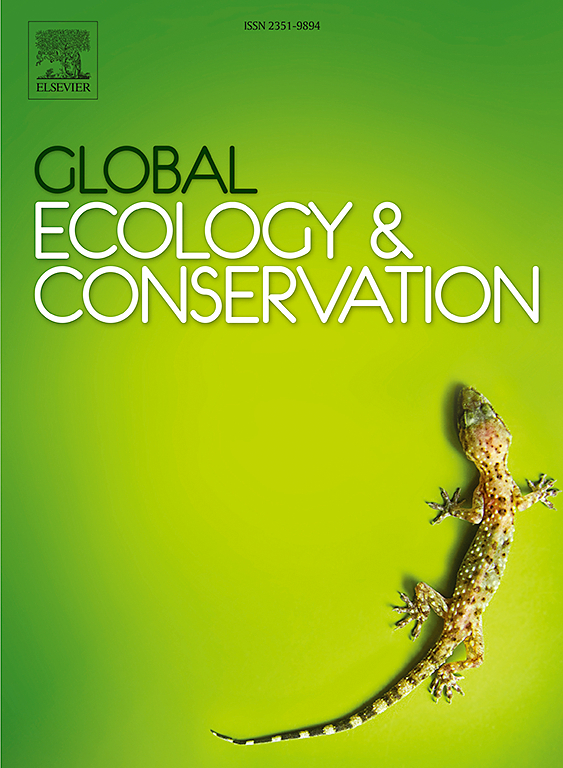Mixing-in native thorny shrubs greatly improves the habitat quality of short rotation coppice strips within a modern agroforestry system for breeding birds
IF 3.5
2区 环境科学与生态学
Q1 BIODIVERSITY CONSERVATION
引用次数: 0
Abstract
Silvoarable agroforestry systems (AFS) with short rotation coppice strips (CS) are novel land-use systems that combine fast-growing trees with croplands to simultaneously produce woody biomass and arable crops. Since their effects on biodiversity remain underexplored, we studied nesting site selection and breeding success of tree- and shrub-breeding birds in three different CS variants, located on an AFS experimental site in northern Germany: CS-C (poplar clones only), CS-A (aspen trees and poplar clones) and CS-E (native woody species and poplar clones). Thereby, the study focused on the question of whether CS can be enhanced for breeding birds by integrating native woody plants that typically grow in hedgerows (variant CS-E). CS-E significantly outperformed CS-C and CS-A, hosting two-thirds of all nests, 70 % of breeding attempts, and two-thirds of successful broods, despite comprising only one-third of the CS area. Native woody plants, covering only about 10 % of the total CS area, accounted for nearly 70 % of all nests and two-thirds of breeding attempts and successful broods. By contrast, poplars (aspen and poplar clones as the actual crop), occupying nearly 90 % of the CS area, accounted for only 30 % of all nests and breeding attempts, respectively, and 22 % of successful broods. Number of nests per 1000 trees was 13 times higher in native woody plants (26.0) than in poplars (2.0) and thorny shrubs of the Rosaceae family such as Rosa or Crataegus species and Pyrus pyraster were particularly preferred for nesting. To improve the habitat quality for breeding birds, we therefore recommend the integration of native woody plants, especially thorny Rosaceae species, into CS in modern AFS.
在现代农林系统中混入本地带刺灌木可大大提高短轮伐林带的栖息地质量,有利于鸟类繁殖
短轮作林带复合农林业系统(AFS)是一种新型的土地利用系统,它将速生树木与农田结合在一起,同时生产木质生物质和可耕地作物。由于其对生物多样性的影响尚未得到充分的研究,我们在德国北部的AFS试验点研究了3种不同的CS变异:CS- c(仅杨树无性系)、CS- a(白杨树和杨树无性系)和CS- e(本地木本物种和杨树无性系)中树木和灌木繁殖鸟类的筑巢地点选择和繁殖成功率。因此,本研究关注的问题是,是否可以通过整合通常生长在树篱中的本地木本植物(变体CS- e)来增强CS在鸟类繁殖中的作用。CS- e的表现明显优于CS- c和CS- a,拥有三分之二的巢穴,70% %的繁殖尝试和三分之二的成功孵化,尽管CS面积仅占三分之一。本土木本植物仅占CS总面积的10% %,却占所有巢穴的近70% %,占繁殖尝试和成功繁殖的三分之二。相比之下,杨树(以杨树和杨树无性系为实际作物)虽然占CS面积的近90% %,但其巢数和繁殖尝试数分别仅占30% %和22% %。原生木本植物的巢数(每1000棵树26.0个)是杨树的13倍(每1000棵树2.0个),而蔷薇科多刺灌木如蔷薇、山楂和Pyrus pyraster尤其适合筑巢。为了改善鸟类的栖息地质量,我们建议在现代AFS中引入本土木本植物,特别是多刺蔷薇科植物。
本文章由计算机程序翻译,如有差异,请以英文原文为准。
求助全文
约1分钟内获得全文
求助全文
来源期刊

Global Ecology and Conservation
Agricultural and Biological Sciences-Ecology, Evolution, Behavior and Systematics
CiteScore
8.10
自引率
5.00%
发文量
346
审稿时长
83 days
期刊介绍:
Global Ecology and Conservation is a peer-reviewed, open-access journal covering all sub-disciplines of ecological and conservation science: from theory to practice, from molecules to ecosystems, from regional to global. The fields covered include: organismal, population, community, and ecosystem ecology; physiological, evolutionary, and behavioral ecology; and conservation science.
 求助内容:
求助内容: 应助结果提醒方式:
应助结果提醒方式:


